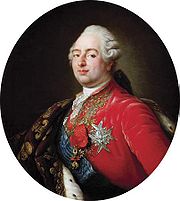
Antoine-François Callet
Encyclopedia

Louis XVI of France
Louis XVI was a Bourbon monarch who ruled as King of France and Navarre until 1791, and then as King of the French from 1791 to 1792, before being executed in 1793....
.
He won the grand prix de Rome
Prix de Rome
The Prix de Rome was a scholarship for arts students, principally of painting, sculpture, and architecture. It was created, initially for painters and sculptors, in 1663 in France during the reign of Louis XIV. It was an annual bursary for promising artists having proved their talents by...
in 1764 with Cléobis et Biton conduisent le char de leur mère au temple de Junon (Kleobis and Biton
Kleobis and Biton
Kleobis and Biton are the names of two human brothers in Greek mythology. It is also the name conventionally given to a pair of lifesize Archaic Greek statues, or kouroi, which are now in the Delphi Archaeological Museum, at Delphi Greece...
dragging their mother's cart to the temple of Juno
Juno (mythology)
Juno is an ancient Roman goddess, the protector and special counselor of the state. She is a daughter of Saturn and sister of the chief god Jupiter and the mother of Mars and Vulcan. Juno also looked after the women of Rome. Her Greek equivalent is Hera...
). He was accepted by the Académie des beaux arts in 1779, with his entry piece being a portrait of the comte d'Artois
Charles X of France
Charles X was known for most of his life as the Comte d'Artois before he reigned as King of France and of Navarre from 16 September 1824 until 2 August 1830. A younger brother to Kings Louis XVI and Louis XVIII, he supported the latter in exile and eventually succeeded him...
, and received with his allegory Le printemps (Spring) in 1781. He exhibited at the Salon from 1783 onwards. He painted the centre of the ceiling of the grande galerie of the palais du Luxembourg, with a composition entitled L'Aurore (Aurora
Aurora (mythology)
Aurora is the Latin word for dawn, the goddess of dawn in Roman mythology and Latin poetry.Like Greek Eos and Rigvedic Ushas , Aurora continues the name of an earlier Indo-European dawn goddess, *Hausos....
). Under the French Consulate
French Consulate
The Consulate was the government of France between the fall of the Directory in the coup of 18 Brumaire in 1799 until the start of the Napoleonic Empire in 1804...
and the First French Empire
First French Empire
The First French Empire , also known as the Greater French Empire or Napoleonic Empire, was the empire of Napoleon I of France...
he painted several more allegories, including an Allégorie du dix-huit brumaire
18 Brumaire
The coup of 18 Brumaire was the coup d'état by which General Napoleon Bonaparte overthrew the French Directory, replacing it with the French Consulate...
ou la France sauvée (Allegory of 18 Brumaire, or France saved - 1801, château de Versailles) and an Allégorie de la bataille d'Austerlitz
Battle of Austerlitz
The Battle of Austerlitz, also known as the Battle of the Three Emperors, was one of Napoleon's greatest victories, where the French Empire effectively crushed the Third Coalition...
(Allegory of the Battle of Austerlitz - 1806, château de Versailles).
External links
- La Tribune de l'Art, on a document by Antoine Callet at auction, later bought by the Parisian gallery Didier Aaron.

